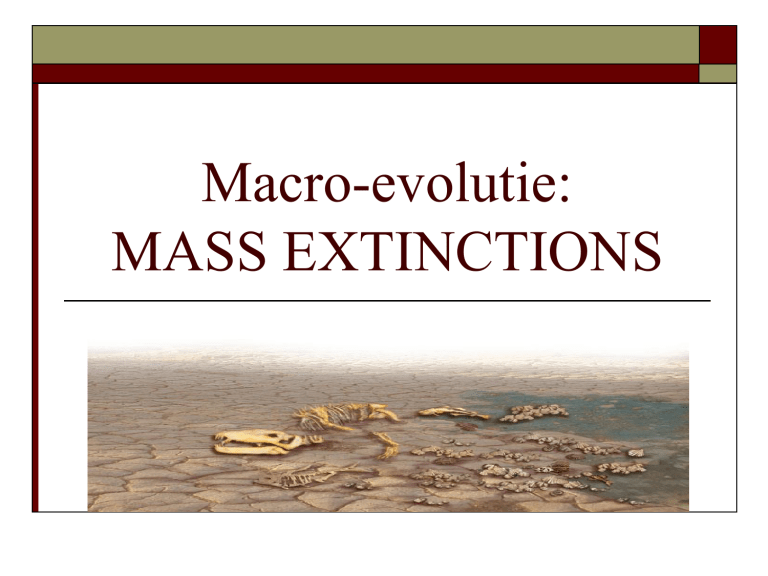
Macro-evolutie:
MASS EXTINCTIONS
Mass extinctions
Diversification and extinctions in the History of Life
(1995) M.J. Benton
How to kill almost all life: the end-Permian
extinction event (2003) M.J. Benton & R.J. Twitchett
Recovery from the most frofound mass extinction of
all time (2008) S. Sahney & M.J. Benton
Diversification and extinction in the history of
life
1 enkele voorouder < Precambrium (3500Ma?)
Nu: 5 – 50 miljoen soorten
door diversificatie
Diversificatie: onderbroken door extincties
Vroege Cambrium
Laat Devoon
Vroege Trias
Eind-Krijt
Laat Ordovicium
Late Perm
Late Trias
Diversification and extinction in the history of
life
Snelheid v. diversificatie:
Ééncelligen: weinig gegevens
Multicellulaire organismen:
Precambrium: traag
Paleozoicum (570-250Ma) : gematigd
vanaf Mesozoicum (250Ma) tot nu:
exponentieel
Diversification and extinction in the history of
life
Explosies van grote taxonomische groepen:
invasies nieuwe habitats
ontwikkelen nieuwe adaptaties
Totale diversiteit van het leven stijgt (clade addities)
Diversification and extinction in the history of
life
Hoe kunnen fossiele gegevens het patroon
van de ‘history of life’ juist weergeven?
1)
De voorstelling is juist
De voorstelling is fout door slechte sampling van gesteentes
2)
Recente kritiek op de toegepaste systematiek
van de gebruikte taxa
Diversification and extinction in the history of
life
Onmogelijk te bepalen of een fossiele familie
monofyletisch is
Onmogelijk te bepalen of alle bestudeerde
taxa evenwaardig zijn aan elkaar
Diversification and extinction in the history of
life
Hoe gebeurt deze indeling dan?
Families en genera van verschillende taxa worden
zodanig gedefinieerd op basis van de taxonomische
keuzes van experts in de betreffende groepen
Op macro-evolutionaire schaal :extreme
diversificaties worden toch duidelijk
verschillende databases vergeleken geen
grote verschillen in macroevolutionaire patronen
Patronen v diversificatie van het leven doorheen de tijd
Diversification and extinction in the history of
life
De ‘big 5’ massa extincties:
Late Ordovicium
Late Devoon
Late Perm: mean family extinction rate = 60,9%
Late Trias
Eind-Krijt
How to kill (almost) all life:
the end-Permian extinction event
Grootste massa extinctie afgelopen 600My
Tot 95% van alle soorten op aarde
Vragen:
tijdstip extinctie?
oorzaken extinctie?
omvang en patroon soortverlies?
manier van herstel?
How to kill (almost) all life:
the end-Permian extinction event
Tijdstip: Perm-Trias grens: 251Ma
Omvang en patroon?
Meishan sectie, China = globale stratotype voor
de PTr-grens:
Rijk in fossielen
Verschillende dateerbare lagen in de successie
How to kill (almost) all life:
the end-Permian extinction event
Extinctie van het leven aan het einde van het Perm, Meishan sectie, zuid - China
How to kill (almost) all life:
the end-Permian extinction event
Oozaak:
?
How to kill (almost) all life:
the end-Permian extinction event
Siberian Traps:
continentale basalt uitvloeiing
2 miljoen km2/ 1-4 km3
How to kill (almost) all life:
the end-Permian extinction event
Global warming ?
Continue gefossiliseerde gesteentesecties nodig
doorheen PTr-grens
zee-gesteentes:
Vóór PTr: hoge diversiteit aan leven, veel fossielen, O2-rijk
Na PTr: weinig & kleine fossielen, donker, vol pyriet: O2-arm
Fusiliden
Claraia
How to kill (almost) all life:
the end-Permian extinction event
Koolstof (C)- isotopen
13C/ 12C in geologische monsters
Hoge productiviteit: veel 12C opname
relatief meer 13C terug te vinden in kalksteen
Tijdens PTr interval:
daling in 13C/ 12C ratio:
enorme stijging 12C
Bron? methaan < smelten v bevroren gashydraat-bodies
Global warming
How to kill (almost) all life:
the end-Permian extinction event
‘Runaway Greenhouse’
Mass extinction
Recovery from the most profound
mass extinction of all time
Herstel bij de Tetrapoda?
Door End-Perm events: 2/3 tetrapoden uitgestorven
procolophonoid
archosauromorpha
dicynodont
Recovery from the most profound
mass extinction of all time
Vroege Trias:
klein aantal genera
Amfibieën: relatief snel herstel
Karoo Basin
Diversiteitsherstel meten:
Locaties waarin complete
gemeenschappen goed
bewaard bleven
Recovery from the most profound
mass extinction of all time
1) Olson’s extinctie
2) End-Guadalupian extinctie
3) End- Perm extinctie
Herstel: snel op globaal level, traag binnen gemeenschap
Recovery from the most profound
mass extinction of all time
Ecologisch herstel:
- Verlies
aan grazers bij PTr grens door verlies aan vegetatie
- Roze: grazers
- Groen: predatoren
- Geel : insectivoren
- Blauw: piscivoren
Recovery from the most profound
mass extinction of all time
Geen snel herstel in vroeg of midden Trias
Pas 30 My na de eind- Permiaanse extinctie
Terug grote diversiteit binnen tertapoden










